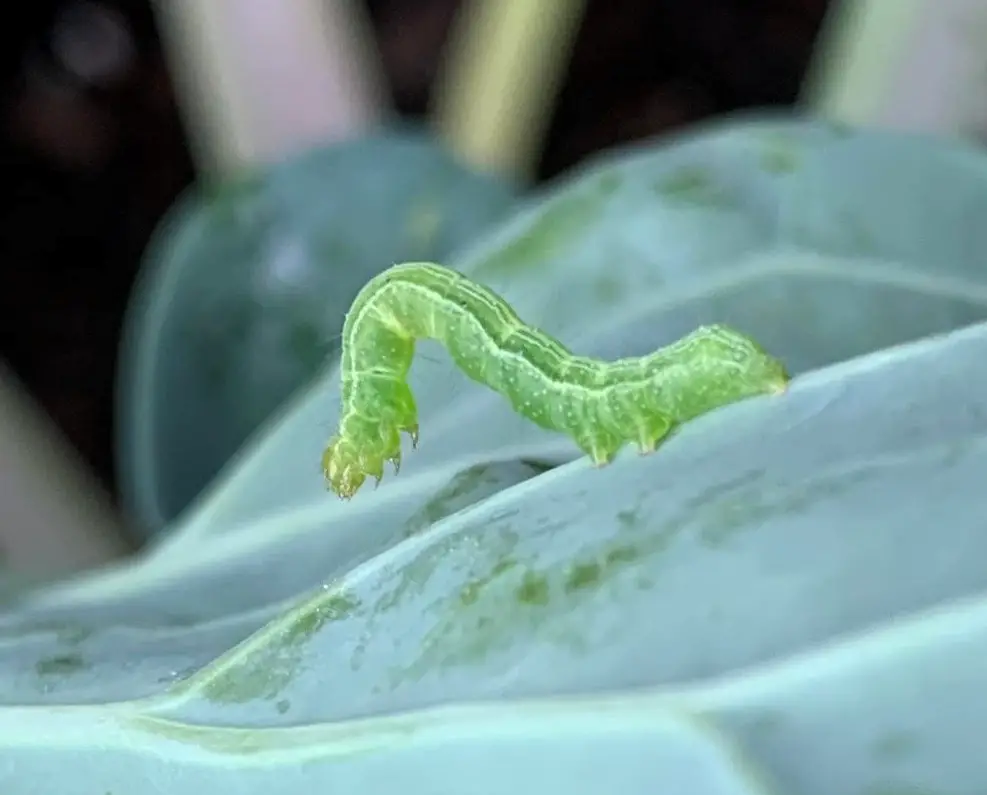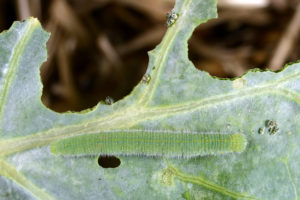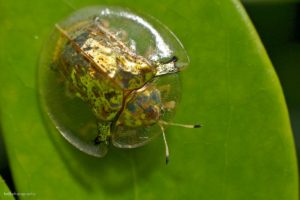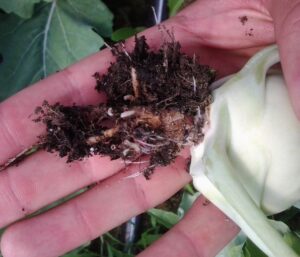If you haven’t seen a cabbage looper in person, just wait. It is a common pest and one of the easiest to identify in the home garden. The light green caterpillar (larva), found throughout North America and Mexico, has white stripes down its back and measures approximately 1 to 2 inches in length, depending on its larval stage. What makes this caterpillar easy to identify is the way it moves. The location of its legs, three pairs of “true legs” located behind its head, and three pairs of “false legs” at the opposite end, causes it to arch its back and make a loop shape when it moves. This type of movement is also characteristic of inchworms.
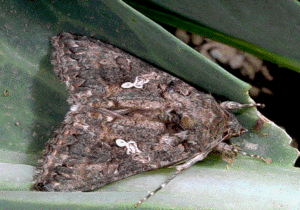
The cabbage looper is the larval stage of the nocturnal mottled gray-brown moth, which has a wingspan of 1.5″. It carries a distinct cream-colored marking on each wing. It should not be confused with the imported cabbage white butterfly, which is approximately the same size as the cabbage looper moth, but whose upper wings are off-white, and underwings are pale yellow. The forewing of the cabbage white, as it is also known, has two black spots if it is a female or one if it is a male. In contrast to the cabbage looper, the larval stage of the cabbage white is a velvety green caterpillar with a faint yellow stripe in later instars. Although the cabbage white is different than the cabbage looper, the degree of destruction is the same.[1]
The cabbage looper should also not be confused with the cucumber moth worm (caterpillar). Both have the characteristic white stripes down their backs, but unlike the cabbage looper, the cucumber moth worm does not loop or move like an inchworm.
Telltale Signs of Cabbage Loopers
Cabbage loopers are chewing insects that can be present anytime during the growing season. They have a voracious appetite and generally feed on the underside of leaves when they are young. As they mature, they will also feed on new growth and leave irregularly shaped holes with jagged edges in the outer leaves. Looper excrement is often visible among the leaves.
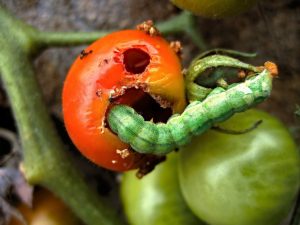
Cabbage loopers have a penchant for members of the cruciferous or brassica family. These include cabbage, broccoli, cauliflower, Brussels sprouts, kale, radishes, and turnips. However, loopers also feed on a wide variety of other plants including, beets, tomatoes, potatoes, lettuce, spinach, celery, cucumbers, and parsley.
Loopers can cause damage to the host plants by consuming large portions of the plant’s leaves, thus reducing its ability to photosynthesize which results in stunted plant growth. The damage can be so severe that the produce is not fit for consumption. In addition, heavy feeding can cause skeletonization and defoliation rather quickly if left unchecked.
Life Cycle
Cabbage loopers overwinter in the pupa stage, with the cocoon attached to a preferred host plant or in yard or garden debris. When the adult emerges in the spring, it mates, and the females will lay their pale yellow-white, domed-shaped eggs, singly or sometimes in small clusters, usually on the underside of leaves.
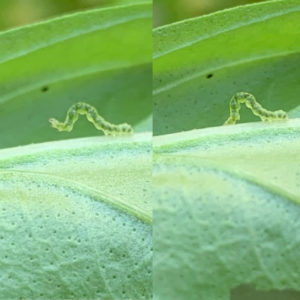
Three or four days later, caterpillars will emerge to begin the maturation process, going through several instars during the next four weeks. This is the most destructive stage of the cabbage looper because they will chew holes in the leaves and bore into the center of cabbage heads, eating three times their body weight in a single day. At the end of the caterpillar stage, they will spin a silken cocoon and transform into 3/4″ long pupae. Thirteen days later, an adult moth will emerge, and the life cycle will continue until winter. The cabbage looper can reproduce several generations each year.
This article contains affiliate links. If you make a purchase using a link, I will receive a very small commission at no additional cost to you, and it will help me maintain this website. Rest assured, I only recommend products I like!
How to Prevent Cabbage Loopers
The key to prevention is to frequently inspect the plants in your garden. The more you check your plants, the quicker you’ll see signs of potential trouble.
Before there are any signs of caterpillar damage, consider spraying an organic neem oil and soap solution as a preventative measure. Choose a neem oil that is cold-pressed and contains the naturally occurring chemical called Azadirachtin. It will act as an antifeedant. This is the neem oil I use.
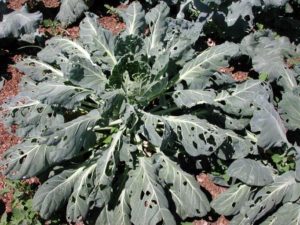
The following DIY recipe can be added to a spray bottle for ease of application: Add 1 teaspoon of neem oil, 1/2 teaspoon of Castile soap like Dr. Bronner’s or Dr. Wood’s, or other liquid, chemical-free soap, to 1 quart of water. Mix well. Do a test spray on one leaf and wait 24 to 48 hours to make sure the mixture is not too strong. If the leaf is damaged, decrease the amount of neem oil. If there is no damage, spray the plants, making sure to cover both sides of the leaves. Repeat every 7 to 14 days as a preventative measure. If it rains, repeat. If the solution does not seem to be effective, increase the amount of neem oil to as much as 2 teaspoons. Do another test spray. Do not apply during the day as the combination of sun and neem oil can burn the plant. Instead, apply during the cool early morning hours or in the early evening.
Another way to prevent cabbage loopers from making their home in your plants is to clean the garden, as well as adjoining areas of weeds and plant debris. Minimizing or eliminating places where the loopers overwinter will help reduce their numbers in the spring.
One more method to prevent cabbage loopers from laying their eggs on your brassicas is to install row covers over seedlings and young plants. If you wait too long to install the covers, the moths will have an opportunity to lay their eggs, and the emerging caterpillars will be trapped inside the protective covering.
How to Get Rid of Cabbage Loopers
The best way to manage cabbage loopers is to start as soon as you see signs of trouble because once they get established, it can be challenging to get rid of them. Here are some steps you can take to organically eliminate these hungry caterpillars:
1. Inspect your garden often, especially in the early morning or evening, when the loopers are more active. Remove any eggs and larvae and dispose of them. It is important to be vigilant.
2. If you have already discovered the presence of cabbage loopers, remove them and any eggs you find. Once the plants are insect-free, you can install row covers, just be sure to continue to inspect your plants in case you missed any.
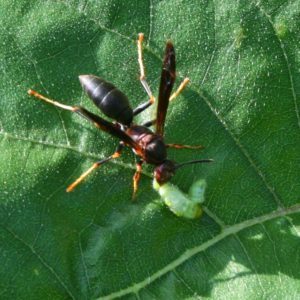
3. Apply an insecticidal soap spray by mixing 1 to 2 teaspoons of a Castile soap, like Dr. Bronner’s or Dr. Wood’s, in one quart of water (or 1 tablespoon in one gallon of water). Be sure to do a test spray. Spray the entire plant, including the underside of the leaves and any new growth. Do not spray during the day as the combination of soap and sunlight could burn your plants. Wait until the cool of the evening or the early morning. Repeat every 7 days.
4. Spray the neem oil solution, as mentioned above. In addition to acting as an antifeedant, neem oil will kill the caterpillars about three days after they ingest it. The solution should also kill the eggs. Repeat every 7 days.
5. Plant resistant cabbage varieties such as Mammoth Red Rock, Chieftan Savoy, Green Winter, and Savoy Perfection Drumhead.
6. Encourage cabbage loopers’ natural predators, such as birds, parasitic wasps, spiders, and ladybugs, to visit your garden by planting species that will attract them. Alternatively, you can purchase parasitic wasps and ladybugs online or from your local plant nursery.
While cabbage loopers are definitely a threat to the garden, if you remain vigilant, you can minimize any damage that may occur and quite possibly eliminate it altogether.
Note: Thank you for reading this article! If you found it helpful, please consider sharing it with others via email or social media!
[1] Another variety worth investigating is the Southern cabbage worm. The adult stage is known as the checkered white butterfly and the larva stage is a green caterpillar with yellow striping and black spots.
